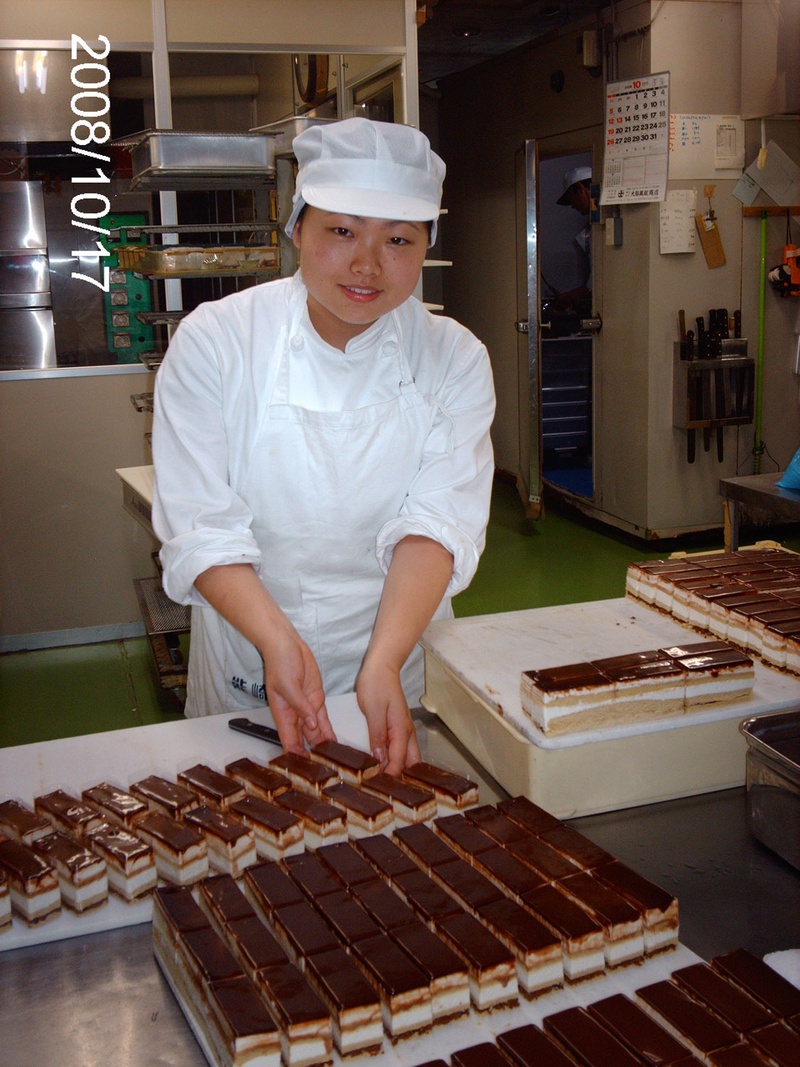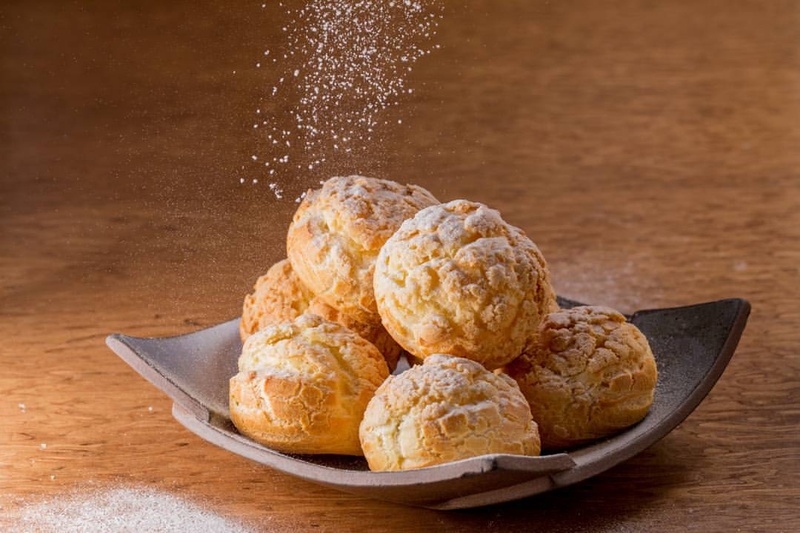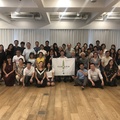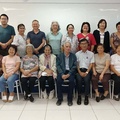Many people in Brazil tend to assume that Nikkei are interested exclusively in Japanese culture. If a Nikkei is keen on sports, the sport must be karate; if s/he likes music, it must be enka; if s/he draws, it must be manga. While these assumptions may occasionally be true, they are not 100% accurate.
Vivianne Hitomi Wakuda is a 29-year-old Brazilian Sansei Nikkei. She is also a pastry chef. “In my first job interview, they assumed I worked with red bean paste. I immediately explained that I worked in the house pastry style, which was French. I am very fond of French pastry and I want to keep myself on this path. It doesn’t prevent me from learning a little about wagashi or using some Japanese ingredients, but overall I prefer to follow the Western style.”
Wagashi refers to traditional Japanese confections. Yogashi, on the other hand, refers to Western-style confections. “The sweets served in Japanese tea ceremonies are wagashi,” Wakuda explains. “They are usually flower-shaped, referencing nature, and they often have a high concentration of sugar, perhaps because they were invented a long time ago and sugar was a way to preserve food. Yogashi are pastries from outside Japan; everything that is not wagashi is yogashi. My work, which has a French influence, is yogashi. It is very interesting that, in Japan, both styles coexist and are always available. I think it’s very nice.”
Wakuda continues: “[Foreign pastries] were often adapted to Japanese tastes. Japanese people are usually motivated to improve a recipe or develop something new from it. For example, I noticed that many yogashi are low in sugar compared to classic French pastries.”
Although the difference between wagashi and yogashi is clear, there are some situations that blur the line between the two.
“[The Japanese] developed their own yogashi classics, like the popular choux cream, which evolved from the classic French pâte à choux (cream puff) and crème pâtissière (pastry cream),” Wakuda says. “The choux cream has less sugar and is lighter than its French inspiration. It is very interesting to see how a French recipe can take on a Japanese personality through flavor modification and the use of Japanese ingredients like green tea, sweet potato, and kabocha (pumpkin). The yogashi I work with has this Eastern influence.”
Wakuda notes that there are pastry shops in Japan that follow only classic French recipes. Those are called yogashi too.
There is not much wagashi to be found in Brazil; its consumption is almost restricted to Nikkei communities. “In my age group, I don’t know anyone who makes only wagashi,” Wakuda observes. “People generally learned the craft from the elderly, but that knowledge has faded a little. There is a wide variety of wagashi available in Japan; in Brazil, not so much. Perhaps a bit of prejudice was created by the consumption of commercial wagashi, which is not so tasty. Wagashi is very tasty if it’s prepared by hand, like any food.”
An opportunity abroad
Wakuda received a degree in gastronomy in 2007. It was during her studies that she realized she was very fond of French pastry. After graduating, she felt it was time to gain some work experience abroad.
“At that time, it was very expensive,” Wakuda says. “My parents could not afford to sponsor me. So, I did some research and discovered Kenpi Kenshu, Japan’s professional internship program, and applied for it. The following year, I was granted an internship in Fukui Prefecture with Osoumenya, a pastry shop that was originally founded as a soumen noodle shop in 1699. I worked in the yogashi section, which was the main, three-story building. The wagashi section was on the other side of the street.”
The internship lasted for eight months, from September 2008 to April 2009. “I couldn’t experience all four seasons, since I didn’t stay for an entire year. But I did notice how the changing seasons affected the food being served [by Osoumenya]—ingredients would change to accommodate each season’s collection.”
Wakuda further describes her experience: “There were no other foreigners on the staff. I went to work as if I were a regular employee. I commuted via bicycle and worked until late afternoon. I did basic tasks at first, then moved on to more complex work. I learned how to operate their machinery, which is different from the machines in Brazil; their machines have more advanced technological features, which reduce the physical effort required. The oven had a conveyor belt, and to make large batches of choux, we used a machine that drips the cream automatically. It helped a lot.”
“On the other hand, some recipes were handcrafted from start to finish,” she continued. “Caramel candy was made in a copper pot, then cut and packed manually. There were some interesting details in their production processes.”
Interns are required to take Japanese classes before beginning the internship, and once they’re there, they have to adapt to a Japanese company’s routine, which is very different from a Brazilian company’s routine. For one thing, daily greetings and behavior are more formal. In Brazil, coworkers quickly start to call each other by their first names. Titles and surnames are only used in more strictly hierarchical environments.
Some former Kenpi Kenshu participants recommend that Nikkei ask to be called by their Western names; that way, their coworkers would be reminded that they are not from Japan and treat them accordingly—with an awareness that they may not be familiar with local etiquette rules. In Wakuda’s case however, coworkers called her by her Japanese middle name (Hitomi) or by her family name.
“I called everyone by their surname,” she says. “Little by little, I got used to that. In the end, it was a smooth process because they had already had other Brazilian interns; they frequently asked about my activities in Brazil and so on.”
“Even though I’m Nikkei, there were differences between us,” Wakuda notes. “The Japanese I spoke was kind of archaic, learned from my grandparents. I was a bit ashamed to speak it. With the passing of the months, I learned a little more and got better at conversations.”
In Brazil, even small companies hire cleaning personnel; in Japan however, regular employees are expected to do the cleaning. “Although there is a hierarchy in place, everyone knows how to do everything,” Wakuda remarks. “From the assistant to the boss, everyone cleaned the toilet, the kitchen, the rest of the facilities.”
In Japanese society, the division between private life and professional life is much more pronounced than it is in Brazil. As a result, it takes more time to develop friendships.
“Not many Brazilians lived there [in Fukui],” Wakuda recalls. “I got together mainly with teachers and the tantousha [local officials in charge of internship affairs], and I frequented a community center. Little by little, friendships were built, but getting closer was difficult. Only at the end did I feel more comfortable.”
In her free time, Wakuda rode her bicycle. “Two other interns, a Brazilian and an Argentinian, rode with me a lot. It is not as dangerous to ride in Japan as it is in Brazil, so we went to a lot of places, mostly to eat, to explore more of Japanese cuisine as well as other pastry shops.”
“Everything was new to me,” Wakuda reminisces. “I was very young and very shy too. Because it was my first time outside of Brazil, I was a bit lost. It was a unique experience and I matured a lot as a person. We were by ourselves, with no father or mother around to guide us.”
Professional direction
At Osoumenya, Wasuda was asked to choose her area of specialization. She chose yogashi for practical reasons: first, the ingredients for wagashi would be harder to find once she returned to Brazil, and second, mastering the handicraft of wagashi would take much longer than the eight months she had in Japan. Wakuda was keen to return to Brazil: “Travelling is good, but you just miss your family at some point.”
Wakuda did do some wagashi work while she was at Osoumenya, and greatly admired the production process. One chef she observed had been practicing his craft there for 40 years. “The sweets are made one by one, by people with a great deal of hands-on experience,” she recalls. “In the blink of an eye, a sakura was created—perfect and wonderful. There was fire on the ground to heat the iron rod that makes the markings on sweets such as manju. It was really beautiful, and completely different from what we have in Brazil.”
“It would take 10 years of apprenticeship to be able to prepare something decent enough to offer to a wagashi customer,” Wakuda observes. “Such devotion is remarkable. The manager of Osoumenya’s yogashi section has also been there for 40 years. That does not happen in Brazil, where five years is already considered a long time.”
Learn it there, apply it here
One of the main purposes of Kenpi Kenshu is for interns to gain knowledge and skills that they can apply back in their home country. However, not all Japanese methods can be easily applied elsewhere.
Wakuda cites the intense level of focus she saw in Japan: “At work, there was no noise. It was completely silent. There was no conviviality the way there is in Brazil. You might hear the sound of machinery, but no talking. This was important for maintaining focus; with confectionery, a distraction might cause some ingredient to be omitted, which would ruin the whole recipe. So, I learned to pay very close attention to what I was doing, and also to keep everything clean and orderly for the sake of other workers.”
How did Wakuda deal with such a different culture? “I did not interfere; I tried to adapt and do my best in any given working environment. Later, in situations where I was in charge, I would try to apply what I had learned in Japan.”
There was one incident during Wakuda’s internship in which she made a mistake. “I forgot an ingredient and got the entire recipe wrong. It could be fixed, but it took much time. I was scolded, but they weren’t rude. I was sad that I caused trouble, that someone had to waste their time to fix my mistake. So I made the effort to avoid that in the future.”
“Japanese culture tells us to be patient, to have discipline in order to achieve goals,” she reflects. “If it is not the right moment to do something, they will tell us. We have to respect those who have experience. When we are young, we might get angry, but that is only immaturity. Sometimes, reprimands are needed to teach us to respect others.”
Seasonality, and the availability of fresh ingredients, is another concept she learned that stands out for Wakuda. “It is very important to know that, from time to time, ingredients will change and we will be granted the opportunity to work with them. This is a concept I can apply in Brazil.”
Developing Brazilian pastry
According to Wakuda, Brazilian pastry, like the country itself, is very young and full of potential.
“There are a lot of ingredients here that people are not aware of,” she explains. “Recently, I learned that there are 23 types of Brazilian vanilla—and yet, we use only a few of them. There are ingredients from the Amazon that I’ve never used and wouldn’t know how to use. I want to go to the northern and midwestern regions of Brazil to research ingredients. It is difficult to just pick up an unknown ingredient and try to use it somehow; ideally, you would talk to someone to learn the best applications. Brazilian ingredients are very strong and have great personality; we need to proceed cautiously and do a lot of tests.”
Contemporary Japanese methods may exert a positive influence in terms of reducing the sugar levels of Brazilian pastry. “Traditional Brazilian pastry, which was influenced by the Portuguese, is still very sweet,” Wakuda explains. “But sweets do not need to only be ‘sweet’; the flavor should be highlighted. Even in traditional sweets, if the sugar is taken out, the recipe will not go wrong. Eating a sweet should be a pleasant and happy experience, not a regretful one.”
Origins
Wakuda was raised in Ibiúna, a municipality in the state of São Paulo. “My parents are farmers. I used to help them prepare seedlings and plant, harvest, and sell the produce. There was the notion of different harvest times; each vegetable or fruit had its time. It was very beautiful, despite such hard daily work—watching a tiny seed become a head of lettuce was satisfying. In the same way, I like to watch pastries change as they are mixed and baked; it is enchanting.”
Wakuda was inspired to learn cooking because she had a great variety of fresh produce right at home. “If I wanted to prepare any dish, it was just a matter of going out and grabbing the ingredients. My bachan cooked too, she used to make miso, konhaku… It was familiar to me. I learned to cook early in life because I was close to my bachan and to all that produce.”
A special childhood memory revolves around cakes and birthday parties. “My maternal grandfather loved celebrating birthdays. Every year, there would be a cake and a poster that said ‘tanjyoubi omedetou [happy birthday] Hitomi’ and my age. That meant a lot.”
Recognition
In 2014, Wakuda was named Pastry Chef of the Year by a well-known food magazine. Many food-focused publications have written about her work. “It is important because it is drawing attention to this unique pastry style,” Wakuda says. “I am happy to be able to spread a little of what I’ve learned in Japan.”
In addition to taking commissions and supplying desserts to restaurants in São Paulo, Wakuda teaches classes and workshops. “Customers say to me, ‘I feel like you really like your job.’ It’s true, I don’t want to do it in a rote way. I know that someone who buys a birthday cake wants to celebrate a special day, so I work hard to prepare something nice, from start to finish, in order to provide a pleasant experience that is beautiful and tasty.”
Nikkei customers have their own feedback. “Nikkei who have already visited or lived in Japan say they miss the sweets they tried there. Mine are not entirely the same, since the ingredients are different, but the customers are moved nonetheless. ‘Oh, I used to eat this in Japan! It’s very similar! I am happy I ate this!’ Hearing that brings me a lot of satisfaction.”
Continuing her parents’ work in farming was an option for Wakuda. However, she chose gastronomy as a way to continue working with food. “They said to me: if this is what you want, we support you, but you have to work together with us. They gave me this opportunity. So, I had to pursue it. I feel the responsibility to return the opportunity they gave me. I feel grateful every day. Back at our farm, even with all hardships, I’ve always felt that my parents loved their job. That is something I take with me in my own life.”
© 2017 Henrique Minatogawa









